The debate in Washington over how to avoid the impending fiscal cliff has had little impact on the public’s views of the tradeoff between reducing the budget deficit and spending to help the economy recover. As has been the case for more than a year, nearly as many say they would place greater priority on spending to help revive the economy (45%) as on reducing the budget deficit (49%).
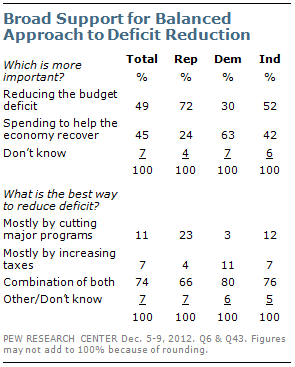
The budget deficit also continues to be viewed as a less worrisome economic concern than the job situation. Four-in-ten (40%) say the job situation is the national economic issue that worries them most, while 25% say the federal budget deficit is their top economic worry.
The public’s preferred approach for dealing with the budget deficit remains a combination of cuts in major programs and tax increases. In fact, the percentage saying the best way to reduce the deficit is to cut programs and raise taxes has increased to 74% from 69% in September and 60% in July 2011.
There are wide partisan divisions over whether reducing the budget deficit or spending to help the economy recover should be the greater priority for the federal government: Republicans, by 72% to 24%, say the priority should be deficit reduction. Democrats, by almost as wide a margin (63% to 30%), view spending to help the economy as more important. Independents, by 52% to 42%, say reducing the deficit is a greater priority.
However, substantial majorities of Democrats (80%), Republicans (66%) and independents (76%) say the best way to reduce the deficit is with a combination of program cuts and tax increases. Since July 2011, the proportion of Republicans favoring a combination of program cuts and tax increases to reduce the deficit has risen by 20 points, from 46% to 66%. During this period, the percentages of Democrats and independents favoring a balanced deficit reduction approach also have risen by 13 points each.
The public continues to be skeptical that progress will be made in reducing the deficit; 44% say the country will have made significant progress in five years while 50% disagree. Somewhat more say that progress will be made on the deficit than did so in July 2011 (39% said significant progress will be made while 51% disagreed).
Democrats are far more optimistic that the deficit can be tackled in the next five years. A majority of Democrats (65%) say significant progress will be made in five years, up 15 points since last July. By contrast, 40% of independents express this view, while 55% say that progress will not made. Just 23% of Republicans think progress will be made in five years, down from 36% last year. Fully 73% are skeptical progress will be made.
This comports with the findings of a Pew Research Center/Washington Post survey conducted last week, in which Democrats were substantially more likely than Republicans to think an agreement would be reached before the Jan. 1 fiscal cliff deadline.
Little Support for Most Specific Deficit Options
Among a dozen specific spending and tax options for reducing the national debt and deficit, only three win majority approval from the public – raising the tax rate on incomes over $250,000 (69% approve), limiting the amount of deductions a taxpayer can claim (54% approve) and raising the tax rate on investment income (52% approve). While limiting deductions overall receives majority support, fewer (41%) support limiting the home mortgage interest deduction.
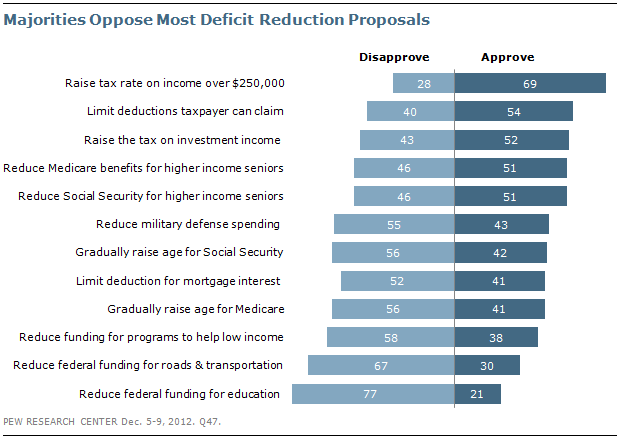
At the other end of the spectrum – cuts in federal funding for education, transportation and the poor are particularly unpopular. Fully 77% disapprove of cuts in education, 67% oppose reduced funding for roads and transportation and 58% disapprove of cuts in federal aid to the poor. In addition, 55% disapprove of reductions in military defense spending while 43% approve.
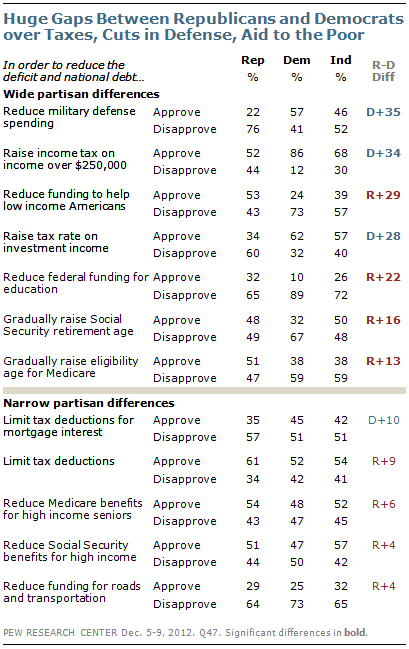
When it comes to changes to entitlements, the public is divided over whether Social Security and Medicare benefits should be reduced for seniors with higher incomes (51% approve while 46% disapprove for each). A majority of Americans disapprove of gradually raising the age at which people can begin receiving Social Security and Medicare benefits (56% for each).
There are substantial partisan differences over most of these proposals. Democrats are far more likely than Republicans to support reducing military defense spending and raising taxes on incomes over $250,000 and on investment income. A majority of Democrats (57%) approve of defense cuts, compared with 22% of Republicans.
Similarly, fully 86% of Democrats support raising the income tax on income over $250,000. Republicans are more divided; 52% approve of this while 44% disapprove. A majority of Democrats (62%) support increasing the tax rate on investment income while a majority of Republicans disapprove (60%).
By contrast, Republicans are about twice as likely as Democrats to support cuts in federal funding for programs that help low-income people (53% vs. 24%). And while Republicans are divided over whether to gradually raise the age for Social Security benefits, fully 67% of Democrats disapprove. The pattern is similar for increasing the eligibility age for Medicare. Republicans also are more likely to support cuts in federal funding for education, although majorities across partisan lines disapprove of this.
The partisan differences are much smaller on limiting tax deductions and cutting funding for roads and transportation. Similarly, there are no significant partisan differences on reducing Social Security and Medicare benefits for seniors with higher incomes.
Most See Tax Increases as Necessary to Solve Debt Problem
Most Americans (59%) say that the nation’s debt problem can be solved only if some taxes go up, while 32% say the
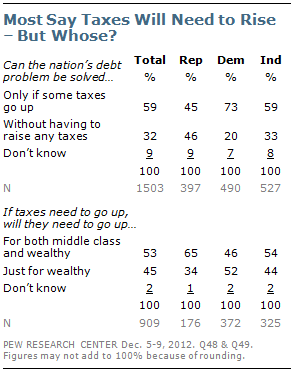
problem can be solved without having to raise any taxes. Among the majority that sees some tax increases as necessary, 53% say taxes will need to go up for the middle class and wealthy, while somewhat fewer (45%) say taxes will need to rise just for the wealthy.
Republicans are divided over whether taxes need to go up at all: 46% say the debt problem can be solved without having to raise any taxes, while about as many (45%) say some tax cuts will be needed. Among Republicans who see some tax increases as necessary, there is broad agreement that they will need to go up for the middle class as well as the wealthy (65% express this view).
Far more Democrats (73%) than Republicans see some tax increases as necessary to solve the debt problem. Yet in contrast to Republicans, Democrats who say tax increases are needed are divided over whether they will need to go up just for the wealthy (52%) or will also need to go up for the middle class (45%).
Mixed Knowledge about Fiscal Cliff
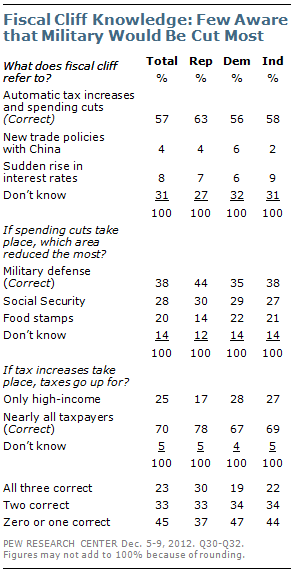
The debate over what to do about the “fiscal cliff” has dominated the news in Washington for the past several weeks, and most Americans say they have been following the story at least somewhat closely. In a separate survey, conducted Dec. 6-9 among 1,001 adults, 63% said they followed the debate in Washington over how to avoid the fiscal cliff very closely (37%) or somewhat closely (26%).
The public’s knowledge about the fiscal cliff is mixed. A majority (57%) knows that the fiscal cliff refers to automatic tax increases and spending cuts that will take effect Jan. 1 if Congress and the president do not act. However, 43% are unaware of this. And just 38% know that most of the spending cuts, if they go into effect, would come out of the budget for military defense.
Overall, just 23% of the public can correctly answer all three questions about the automatic tax increases and spending cuts scheduled to take place. Another third of the public (33%) can answer two of the three items. The remainder (45%) can answer only one or none of the questions correctly.
Republicans are more knowledgeable about the fiscal cliff than either Democrats or independents. Yet even among Republicans, only 30% got all three questions correct and 37% missed at least two. Among Democrats and independents, 19% and 22%, respectively, could answer all three questions correctly. Nearly half of Democrats (47%) and 44% of independents missed at least two items.
However, one group of Republicans stands out as particularly aware of the details of the fiscal cliff standoff: Tea Party supporters. Among Republicans and Republican-leaning independents who agree with the Tea Party, 48% correctly answered all three questions, and another 34% got two out of three correct. Republicans who disagree with the Tea Party or have no opinion about it score no higher than the national average on the subject of the fiscal cliff.